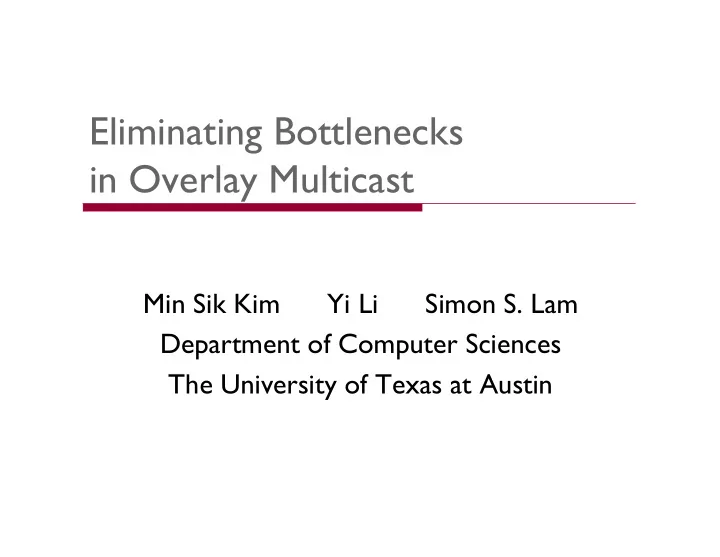

Eliminating Bottlenecks in Overlay Multicast Min Sik Kim Yi Li Simon S. Lam Department of Computer Sciences The University of Texas at Austin
Overlay Multicast IP multicast overlay multicast N unicast Bottleneck How to construct an efficient overlay tree? 2
Eliminating Shared Bottlenecks 1 1 2 2 4 4 3 3 5 5 Shared congestion detection Bottleneck Elimination Why difficult? 3
Outline Introduction Types of Shared Bottlenecks Bottleneck Elimination Performance Evaluation Summary 4
Inter-path Shared Bottleneck u 1 u 2 u 1 v 1 u 2 v 1 v 2 v 2 5
Intra-path Shared Bottleneck u 1 u 2 u 1 v 1 u 2 v 1 v 2 v 2 6
Algorithm Eliminate both types of shared bottlenecks No tree oscillation Remove a shared bottleneck … Tree 1 Tree 2 Tree 3 Tree N One-way process Finite steps 7
Example 1 1 2 3 4 2 4 3 # of leaves ↓ Height ↑ 8
Leaf Distance Vector Depths of all leaf nodes in descending order 1 1 2 3 4 2 4 3 D = (1,1,1) D = (2,1) � 9
Total Cost Sum of costs of all edges in the tree u 2 u 1 u 2 u 1 1 1 1 1 1 1 1 1 1 1 1 1 v 1 v 1 v 2 v 2 C = 3 + 1 + 3 = 7 > C = 2 + 1 + 2 = 5 � u 1 v 1 v 1 u 2 u 2 v 2 u 1 u 2 u 2 v 1 v 1 v 2 10
Proof Sketch Bottleneck elimination algorithms Remove-Inter-Path-Shared-Bottleneck Remove-Intra-Path-Shared-Bottleneck Applying either algorithm causes D ↑ C ↓ Only a finite # of changes 11
Protocol Measure delay for u 1 congested edges Detect shared congestion v 1 Eliminate shared bottlenecks Forward remaining u 2 bottlenecks v 2 12
Performance Evaluation Comparison Delay heuristic Bandwidth heuristic Bottleneck-free Metrics Links stress Link load Relative delay penalty Receiving rate 13
Link Stress 14
Link Load 15
Receiving Rate 16
Relative Delay Penalty 17
Summary Overlay multicast creates shared bottlenecks Proposed tree construction algorithm Eliminates all shared bottlenecks Provides full receiving rate Low link load, low delay 18
Recommend
More recommend